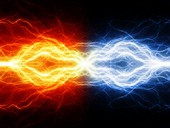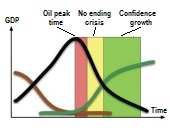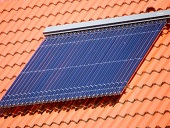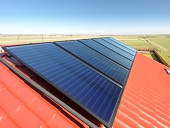Heat released in biomass combustion can be effectively stored in an accumulation tank. Traditionally, water is used as a main heat transfer medium. However, progressive materials, such as Phase Change Materials (PCM´s), offer better heat storage capacities. The materials work on principle of sensible and latent heat accumulation / release. While the phase change material takes up the heat, during the reversed process the stored latent heat is released. In our work the following materials were studied: paraffinic waxes, fatty acids and their eutectic mixtures. These materials provide higher heat potential per unit volume. Therefore, PCM´s can prolong the lifetime of biomass-fired systems.
Archiv článků od 21.2.2010 do 30.8.2010
A revised version of the directive was issued in 2010 under the title 2010/31/EU. In part, it is a modification of the original. In it, there are have been defined new administrative tools to increase the energy performance of buildings - among others, it includes the concept of "building with almost 0 energy consumption".
One of ways how to utilise higher amount of energy from solar irradiation is conversion of energy of incident photons to a level close to band gap of the semiconductor material. This is the main idea of thermophotovoltaics. Light from the Sun (or heat from another source) is absorbed in emitter which is heated to a temperature much lower then the temperature of the surface of the Sun. Heated emitter then emits photons with lower energy. The goal is to manufacture selective emitter which emits photons in narrow band only slightly above to bandap of used photovoltaic cell.
Currently in the Czech Republic we observe relatively large development of energy efficiency projects including energy production from RES, in particular electricity. This development is interconnected with the current legislative framework for such support in the Czech Republic and related support mechanism in the form of investment and operating subsidies for electricity production from RES. Current status of implementation of these projects is particularly affected by our membership in the EU and the subsequent implementation of the EU respective directives into national legislation. Furthermore, the Czech Republic has achieved a significant success in international emissions trading (IET International Emission Trading) by selling its surplus CO2 emissions under the Kyoto Protocol. In comparison with other EU countries the Czech Republic belongs to the frontrunners in terms of implementation of energy efficiency projects, mainly in the context of recent strong development of photovoltaic power installations. The article presents a basic overview of Operational Programmes financed by SCF EU, under which energy saving and RES projects in the private and public sector are supported, the Green Savings programme, designed for household sector and financed by selling CO2 emission surplus, and the system of feed in tariffs for RES electricity production. Based on currently available ex-ante evaluation of the supported projects the article quantifies the anticipated benefits of these projects in terms of savings in the final energy consumption and in terms of increase in energy production from RES.
Currently in the Czech Republic we observe relatively large development of energy efficiency projects including energy production from RES, in particular electricity. This development is interconnected with the current legislative framework for such support in the Czech Republic and related support mechanism in the form of investment and operating subsidies for electricity production from RES. Current status of implementation of these projects is particularly affected by our membership in the EU and the subsequent implementation of the EU respective directives into national legislation. Furthermore, the Czech Republic has achieved a significant success in international emissions trading (IET International Emission Trading) by selling its surplus CO2 emissions under the Kyoto Protocol. In comparison with other EU countries the Czech Republic belongs to the frontrunners in terms of implementation of energy efficiency projects, mainly in the context of recent strong development of photovoltaic power installations. The article presents a basic overview of Operational Programmes financed by SCF EU, under which energy saving and RES projects in the private and public sector are supported, the Green Savings programme, designed for household sector and financed by selling CO2 emission surplus, and the system of feed in tariffs for RES electricity production. Based on currently available ex-ante evaluation of the supported projects the article quantifies the anticipated benefits of these projects in terms of savings in the final energy consumption and in terms of increase in energy production from RES.
The article is a translation of author´s presentation reported in January 2009. Presentation is focused on two strands: 1) Oil Peak and 2) related experience of the structural transformation during the ascent to Oil Peak. The last part is attempting to answer the question "What might the descent from Oil Peak be like?"
In the first part of the article is a brief overview of the market of collectors of solar radiation in the Czech Republic, the basic layout of different types of collectors and major part of solar systems. Following parts provide some basic connection of solar systems for various heating load (hot water, heating, swimming pool) and a simplified design absorber area. Each scheme is briefly described its function. In conclusion, it is marked possible connections of storage tanks for different performance.
In the first part of the article is a brief overview of the market of collectors of solar radiation in the Czech Republic, the basic layout of different types of collectors and major part of solar systems. Following parts provide some basic connection of solar systems for various heating load (hot water, heating, swimming pool) and a simplified design absorber area. Each scheme is briefly described its function. In conclusion, it is marked possible connections of storage tanks for different performance.
This contribution summarizes utilizing of co-generation and tri-generation systems for effective electricity, heat and cool production. A co-generation and a tri-generation offer more effective utilizing of primary energy sources in comparison with separate production of different kinds of energy. This contribution describes actual state in the Czech Republic in year 2009.
What should be respected during renovation works on roofs so as to maintain the architectural quality of the original design? Solar collectors and photovoltaic cells constitute a disruptive element in historical buildings and buildings in historical areas. Among others, the reasons are legal, because the law provides equal access to buildings with a same degree of legal protection. Exceptions can be considered in situations without an indicated conflict. For example, on garage roofs in courtyards or roofs in buildings erected after the WWII. And even in these cases, the installation of panels should be appropriately considered. Of course, even new architectural and artistic works as well as other specific situations will require an individual approach. However, in terms of frequency we are talking about exceptions that confirm the general view of the preservations institutions, that the placement of photovoltaic systems in areas of cultural or historical heritage is not desirable. Let's have a more detailed look at this problematic.
The purchase price of electricity from photovoltaic power plants in the Czech Republic are the highest within the whole of the European Union. Does this mean that support of them in the Czech Republic is also the highest? When compared with similar climate conditions the conclusion is that such interpretation is erroneous.
More than 15 years TZB-info is focused to perspective equipment for building services with priority in heating. During this period the main question: "how to heat" shifted to question: "how to reduce heat loses". For example France is planning for new buildings only passive standard, and begining 2050 only so-called quasi-zero buildings. In Czech Republic one of significant impulses is subsidy program Zelená úsporám (Green for savings). Technical solutions are widely known in professional community, unfortunately high investment cost and long payback time are the main barriers for broader expansion of the solutions. Folowing article is the first from a serie focused to long time planing of reduction of energy consumption in the Czech Republic. From two ways - to prospect new energy sources or to reduce energy consumption - the second needs no to destroy another villages or towns.
How can heating for Czech homes be assured while at the same time get rid of the dependence on dirty coal and Russian gas? This is answered by the scholarly study by the DUHA movement – Clean Heating. The solution is based on a combination of investments on home insulation, solar collectors and biomass heating plants. Very important are the new standards for developers and provisional supply of coal from the Bílina mine. The calculations are based on those from the Pačes Commission. There are many opportunities. Increasing the energy efficiency of builings – i.e. insultaions – and the heating potential from renewable sources represent more than 300 million gigajoule. This surpasses the total current heating consumption of Czech homes. The possibilities of insulating Czech homes are also five and a half times higher than the controversial expansion of the coal mines around Most, which is linked with a further devastation of the North Bohemian landscape and the demolition of towns.
From the point of view of national legislation, solar collectors are considered construction products and so, before being put on the market, must meet the requirements of Law no. 22/1997 “on technical requirements for products and of amending and supplementing certain laws, as amended, laying down technical requirements for products”. These requirements are specified in the Decree no. 163/2002, which lays down the technical requirements for specific buildings products, as amended by the Government Regulation no. 312/2005. Solar collectors are listed as Item 7 in Table 10 (technical equipment of buildings), in Annex 2 - “Equipment for heating spaces with no energy source a) in buildings b) for use, which are subject to required reaction to fire with specific levels ”
Today we have detailed, scientifically based evidence tested in practice, revealing that the construction of new buildings and the renovation of old ones can reduce their energy consumption to values lower than 10% of the current average. This ability of architects, planners, construction workers and companies has arrived just in time to help us avoid the worst consequences of climate change.
Nowadays, the support for the production is renewable energy is growing. Biomass is among the important sources of renewable energy. It can be used in biogas plants as a raw, organic material of various origins, or as a “dry” biomass with low moisture, which is suitable for the production of energy through incineration. Both electricity and heating can be produced with biomass. And that is actually the problem. Whereas the production of electricity is supported, support for the production of heat is still missing.
The current boom of photovoltaic energy installation is such that even the laboratories of the Science Academy of the Czech Republic have been asked which is the best photovoltaic panel. There is no easy answer for such question. The ideal panel should have the highest efficiency, which should be independent of either temperature or intensity of illumination. In addition, the panel should not degrade, nor should need maintenance and should be the lightest, yet strong and durable. Thus far, nobody has built such panel (and price is not even being considered). Will we see in the future more efficient panels? Not easy with the conventional silicon technology. One thing is to build complex technology by way of a record cell of 1cm2, and another, to mass produce square kilometres of low-cost photovoltaic cells. However, the advent of nanotechnology is bringing new ideas that will lead to increased efficiency of photovoltaic cells. Further research and development, together with mass production, are bound to progressively make photovoltaic panels less expensive. In 10-15 years photovoltaics will be able to directly compete with other forms of electricity production, and the installed capacity will be in the hundreds of gigawatts worldwide.
The gross production of electricity from renewable sources in 2008 was 5.2% of the national gross electricity consumption. The share of renewable energy in primary sources reached 5%. The share of renewable energy sources in the production of thermal energy is around 7%. According to the Ministry of Industry and Commerce, in 2009 the share of electricity coming from renewable sources was 6.8% of the final electricity consumption in the Czech Republic.
The calculate the balance of annual fuel requirement it is important to correctly determine the specific calorific value of the fuel and to asses the real efficiency of the boiler itself. Not always this data is consistent with what is reported by manufacturers or retailers of pellets and pellet boilers. Just to get an idea, for a 1kW heat loss the consumption would be 520kg of high quality pellets. This is of course an estimate, because it depends on the concrete weather conditions in a given year (length of the heating season, etc.), but it also depends on the chosen temperature for the heated area (for some people 22ºC is too much, others feel cold even at 26ºC. It is normally calculated that to heat water for a family of four the annual consumption is 25GJ. That, calculated for a boiler and pellets gives as an approximate of 1.7 tonnes of pellets a year.
As of the 1st Octo 2009 is in force in the Slovak Republic the decree 311/2009 Z.z., which lays down the details for he calculation of the energy performance of buildings and the contents of the energy certificate. It is a binding document resulting from the law 555/2005Z.z., in which the Directive 2002/91/EC on the energy performance of buildings is implemented.
zpět na aktuální články





